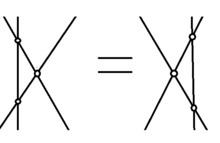In physics, the Yang–Baxter equation (or star-triangle relation) is a consistency equation which was first introduced in the field of statistical mechanics. It depends on the idea that in some scattering situations, particles may preserve their momentum while changing their quantum internal states. It states that a matrix R , acting on two out of three objects, satisfies
( R ⊗ 1 ) ( 1 ⊗ R ) ( R ⊗ 1 ) = ( 1 ⊗ R ) ( R ⊗ 1 ) ( 1 ⊗ R ) In one dimensional quantum systems, R is the scattering matrix and if it satisfies the Yang–Baxter equation then the system is integrable. The Yang–Baxter equation also shows up when discussing knot theory and the braid groups where R corresponds to swapping two strands. Since one can swap three strands two different ways, the Yang–Baxter equation enforces that both paths are the same.
It takes its name from independent work of C. N. Yang from 1968, and R. J. Baxter from 1971.
Let A be a unital associative algebra. The parameter-dependent Yang–Baxter equation is an equation for R ( u ) , a parameter-dependent invertible element of the tensor product A ⊗ A (here, u is the parameter, which usually ranges over real numbers ℝ in the case of an additive parameter, or over positive real numbers ℝ+ in the case of a multiplicative parameter). The Yang–Baxter equation is
R 12 ( u ) R 13 ( u + v ) R 23 ( v ) = R 23 ( v ) R 13 ( u + v ) R 12 ( u ) , for all values of u and v , in the case of an additive parameter. At some value of the parameter R ( u ) can turn into one dimensional projector, this gives rise to quantum determinant. For multiplicative parameter Yang–Baxter equation is
R 12 ( u ) R 13 ( u v ) R 23 ( v ) = R 23 ( v ) R 13 ( u v ) R 12 ( u ) , for all values of u and v , where R 12 ( w ) = ϕ 12 ( R ( w ) ) , R 13 ( w ) = ϕ 13 ( R ( w ) ) , and R 23 ( w ) = ϕ 23 ( R ( w ) ) , for all values of the parameter w , and ϕ 12 : A ⊗ A → A ⊗ A ⊗ A , ϕ 13 : A ⊗ A → A ⊗ A ⊗ A , and ϕ 23 : A ⊗ A → A ⊗ A ⊗ A are algebra morphisms determined by
ϕ 12 ( a ⊗ b ) = a ⊗ b ⊗ 1 , ϕ 13 ( a ⊗ b ) = a ⊗ 1 ⊗ b , ϕ 23 ( a ⊗ b ) = 1 ⊗ a ⊗ b . In some cases the determinant of R ( u ) can vanish at specific values of the spectral parameter u = u 0 . Some R matrices turn into one dimensional projector at u = u 0 . In this case quantum determinant can be defined.
Let A be a unital associative algebra. The parameter-independent Yang–Baxter equation is an equation for R , an invertible element of the tensor product A ⊗ A . The Yang–Baxter equation is
R 12 R 13 R 23 = R 23 R 13 R 12 , where R 12 = ϕ 12 ( R ) , R 13 = ϕ 13 ( R ) , and R 23 = ϕ 23 ( R ) .
Let V be a module of A . Let T : V ⊗ V → V ⊗ V be the linear map satisfying T ( x ⊗ y ) = y ⊗ x for all x , y ∈ V . Then a representation of the braid group, B n , can be constructed on V ⊗ n by σ i = 1 ⊗ i − 1 ⊗ R ˇ ⊗ 1 ⊗ n − i − 1 for i = 1 , … , n − 1 , where R ˇ = T ∘ R on V ⊗ V . This representation can be used to determine quasi-invariants of braids, knots and links.

